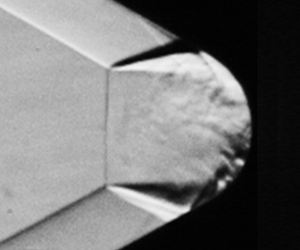Article contents
Transitions of shock interactions on V-shaped blunt leading edges
Published online by Cambridge University Press: 05 February 2021
Abstract

A combination of shock tunnel experiments, numerical simulations and theoretical analyses is conducted on V-shaped blunt leading edges (VBLEs) with a wide range of geometric parameters at a free stream Mach number of 6. The interactions between the shock waves induced by the two straight branches and the crotch of the VBLEs set up intriguing wave structures with increases in  $R/r$ (i.e. the crotch radius
$R/r$ (i.e. the crotch radius  $R$ over the leading edge radius
$R$ over the leading edge radius  $r$) and
$r$) and  $\beta$ (i.e. the half-span angle between the two straight branches), including regular reflection (RR), Mach reflection (MR) and regular reflection from the same family (sRR). These wave structures are observed in shock tunnel experiments and are reproduced by numerical simulations. Of great interest, transitions of shock interactions from RR to MR and from MR to sRR are identified with variation in
$\beta$ (i.e. the half-span angle between the two straight branches), including regular reflection (RR), Mach reflection (MR) and regular reflection from the same family (sRR). These wave structures are observed in shock tunnel experiments and are reproduced by numerical simulations. Of great interest, transitions of shock interactions from RR to MR and from MR to sRR are identified with variation in  $R/r$ or
$R/r$ or  $\beta$. It is revealed that the specific geometric constraints of VBLEs, rather than the classic detachment and von Neumann criteria, govern the transitions of shock interactions. From theoretical analyses of the relative geometric positions of the shock structures near the crotch, transition criteria of the shock interactions on VBLEs are established. These theoretical transition criteria achieve good agreement with the numerical and experimental results for a wide range of
$\beta$. It is revealed that the specific geometric constraints of VBLEs, rather than the classic detachment and von Neumann criteria, govern the transitions of shock interactions. From theoretical analyses of the relative geometric positions of the shock structures near the crotch, transition criteria of the shock interactions on VBLEs are established. These theoretical transition criteria achieve good agreement with the numerical and experimental results for a wide range of  $R/r$ and
$R/r$ and  $\beta$ and thus show great potential for practical engineering applications, such as the selection of geometric parameters for the cowl lip of a hypersonic inlet.
$\beta$ and thus show great potential for practical engineering applications, such as the selection of geometric parameters for the cowl lip of a hypersonic inlet.
JFM classification
- Type
- JFM Papers
- Information
- Copyright
- © The Author(s), 2021. Published by Cambridge University Press
References
REFERENCES
- 15
- Cited by



